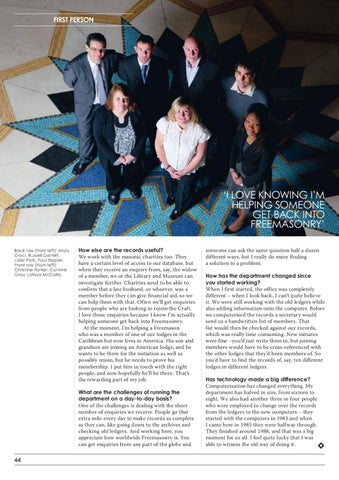FIRST PERSON
ëI LOVE KNOWING IíM HELPING SOMEONE GET BACK INTO FREEMASONRYí Back row (from left): Andy Croci, Russell Garrett, Lister Park, Paul Napier. Front row (from left): Christine Parker, Corinne Gray, Latoya McCalla
How else are the records useful? We work with the masonic charities too. They have a certain level of access to our database, but when they receive an enquiry from, say, the widow of a member, we or the Library and Museum can investigate further. Charities need to be able to confirm that a late husband, or whoever, was a member before they can give financial aid, so we can help them with that. Often we’ll get enquiries from people who are looking to rejoin the Craft. I love those enquiries because I know I’m actually helping someone get back into Freemasonry. At the moment, I’m helping a Freemason who was a member of one of our lodges in the Caribbean but now lives in America. His son and grandson are joining an American lodge, and he wants to be there for the initiation as well as possibly rejoin, but he needs to prove his membership. I put him in touch with the right people, and now hopefully he’ll be there. That’s the rewarding part of my job. What are the challenges of running the department on a day-to-day basis? One of the challenges is dealing with the sheer number of enquiries we receive. People go that extra mile every day to make records as complete as they can, like going down to the archives and checking old ledgers. And working here, you appreciate how worldwide Freemasonry is. You can get enquiries from any part of the globe and
44
someone can ask the same question half a dozen different ways, but I really do enjoy finding a solution to a problem. How has the department changed since you started working? When I first started, the office was completely different – when I look back, I can’t quite believe it. We were still working with the old ledgers while also adding information onto the computer. Before we computerised the records a secretary would send us a handwritten list of members. That list would then be checked against our records, which was really time consuming. New initiates were fine –you’d just write them in, but joining members would have to be cross-referenced with the other lodges that they’d been members of. So you’d have to find the records of, say, ten different lodges in different ledgers. Has technology made a big difference? Computerisation has changed everything. My department has halved in size, from sixteen to eight. We also had another three or four people who were employed to change over the records from the ledgers to the new computers – they started with the computers in 1983 and when I came here in 1985 they were halfway through. They finished around 1988, and that was a big moment for us all. I feel quite lucky that I was able to witness the old way of doing it.
